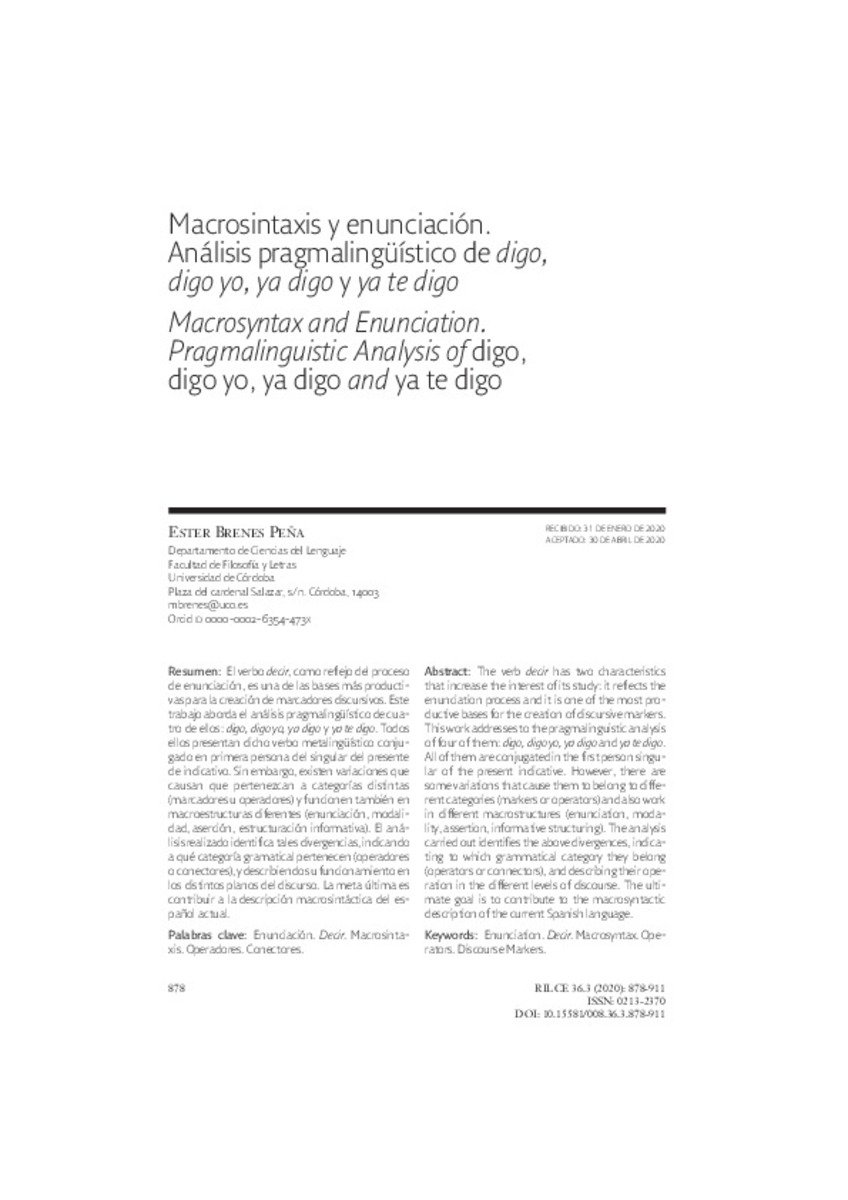Registro completo de metadatos
| Campo DC | Valor | Lengua/Idioma |
|---|---|---|
| dc.creator | Brenes-Peña, E. (Ester) | - |
| dc.date.accessioned | 2020-12-16 | - |
| dc.date.accessioned | 2021-08-24T11:41:21Z | - |
| dc.date.available | 2021-08-24T11:41:21Z | - |
| dc.date.issued | 2020 | - |
| dc.identifier.citation | Brenes-Peña, E. (Ester). "Macrosintaxis y enunciación. Análisis pragmalingüístico de «digo», «digo yo», «ya digo» y «ya te digo»". Rilce: Revista de Filología Hispánica. 36 (3), 2020, 878 - 911 | es |
| dc.identifier.issn | 0213-2370 | - |
| dc.identifier.uri | https://hdl.handle.net/10171/61574 | - |
| dc.description.abstract | The verb <em>decir </em>has two characteristics that increase the interest of its study: it reflects the enunciation process and it is one of the most productive bases for the creation of discursive markers. This work addresses to the pragmalinguistic analysis of four of them: <em>digo, digo yo, ya digo </em>and <em>ya te digo</em>. All of them are conjugated in the first person singular of the present indicative. However, there are some variations that cause them to belong to different categories (markers or operators) and also work in different macrostructures (enunciation, modality, assertion, informative structuring). The analysis carried out identifies the above divergences, indicating to which grammatical category they belong (operators or connectors), and describing their operation in the different levels of discourse. The ultimate goal is to contribute to the macrosyntactic description of the current Spanish language. | en_US |
| dc.description.abstract | El verbo <em>decir</em>, como reflejo del proceso de enunciación, es una de las bases más productivas para la creación de marcadores discursivos. Este trabajo aborda el análisis pragmalingüístico de cuatro de ellos: <em>digo, digo yo, ya digo </em>y <em>ya te digo</em>. Todos ellos presentan dicho verbo metalingüístico conjugado en primera persona del singular del presente de indicativo. Sin embargo, existen variaciones que causan que pertenezcan a categorías distintas (marcadores u operadores) y funcionen también en macroestructuras diferentes (enunciación, modalidad, aserción, estructuración informativa). El análisis realizado identifica tales divergencias, indicando a qué categoría gramatical pertenecen (operadores o conectores), y describiendo su funcionamiento en los distintos planos del discurso. La meta última es contribuir a la descripción macrosintáctica del español actual. | es_ES |
| dc.language.iso | spa | - |
| dc.publisher | Servicio de Publicaciones de la Universidad de Navarra | es_ES |
| dc.rights | info:eu-repo/semantics/openAccess | es_ES |
| dc.subject | Enunciación | - |
| dc.subject | Vervo decir | - |
| dc.subject | Macrosintaxis | - |
| dc.subject | Operadores | - |
| dc.subject | Conectores | - |
| dc.title | Macrosintaxis y enunciación. Análisis pragmalingüístico de «digo», «digo yo», «ya digo» y «ya te digo» | es_ES |
| dc.title.alternative | Macrosyntax and Enunciation. Pragmalinguistic Análisis of «digo», «digo yo», «ya digo» and «ya te digo» | en_US |
| dc.type | info:eu-repo/semantics/article | es_ES |
| dc.identifier.doi | 10.15581/008.36.3.878-911 | - |
| dadun.citation.endingPage | 911 | - |
| dadun.citation.number | 3 | - |
| dadun.citation.publicationName | Rilce: Revista de Filología Hispánica | - |
| dadun.citation.startingPage | 878 | - |
| dadun.citation.volume | 36 | - |
Ficheros en este ítem:
Estadísticas e impacto
Los ítems de Dadun están protegidos por copyright, con todos los derechos reservados, a menos que se indique lo contrario.






